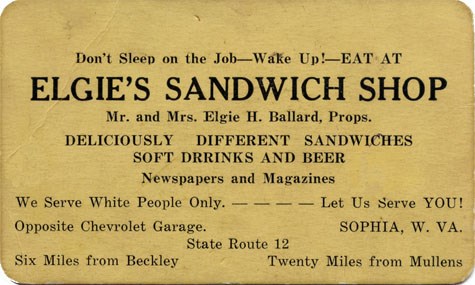
African Americans living in West Virginia after the Civil War experienced an unusual social and racial environment. From the 1870s through the 1950s, thousands of African Americans migrated to the state in search of jobs. Upon their arrival, they were met with segregation and discrimination, but also with economic, political, and educational opportunities that had been denied them in other southern states. Many preferred West Virginia because it provided them the right to vote and educate their children. They came to live in communities which were not suppressed by racist politics and the constraints of Jim Crow laws. Just across the state line in Virginia, Jim Crow laws forced African Americans to use segregated transportation and granted them no voting rights. In West Virginia, African Americans were able to send their children to publicly-funded schools. They could ride on the same bus as white people. They were able to participate in local politics. Through their vote, they were able to elect African Americans to local school boards, law enforcement offices, city councils, and the state legislature.1 Segregation and racism was present in other ways. It existed in coal camps and railroad towns, in the mines, and on the railroad. Black and white residents lived in different neighborhoods, worshiped in separate churches, and attended segregated schools. Many towns had a “white neighborhood” and a “black neighborhood” that separated where residents lived. Housing for African Americans was often inferior and located in the less desirable part of town. The section of town where black residents lived was on the far end of town away from the company store and other amenities. Helen Powell relates that in the Collins Hill area of Glen Jean, the “black section” did not have running water like the “white section” did.2 African American workers faced racism on the job as well. On the railroad, there were white-only jobs, the engineers, conductors, and supervisors. Black workers did jobs that included porters, baggage handlers, and track crews. In the mines, white miners were almost exclusively hired as supervisors, fire bosses, and motormen. African Americans were hired into jobs as coal loaders and mule handlers, which were more labor intensive positions. Even though segregation prevailed, black miners were offered the same type of housing, rental rates, and equal wages as white miners. Black and white miners typically intermingled while eating lunch, gathering their equipment, and riding shaft elevators and underground rail cars. However, they showered and changed in segregated bath houses and went home to separate neighborhoods. 
“Our communities were segregated and I lived in a small coal camp. We grew up basically playing ball together every day. We used to have segregated competitions a lot of times. The blacks would play the whites in a Sunday afternoon football game. All of us would meet down at the ball field at two o’clock and the blacks would play the whites.3 African-American life was shaped by more than segregation and discrimination. Black citizens drew on their cultural traditions and their power at the ballot box to create strong communities. They invested in their churches, fraternal and professional organizations and communities. These provided a sense of belonging, opportunities for leadership, and means for spiritual and material improvement. Schools became vital institutions in the African-American community. They did more than educate and socialize black children. They provided leadership and social opportunities for both students and adults within the African American community.4 Although black and white residents lived in separate neighborhoods and patronized segregated restaurants and theaters, they did work closely in the mines and sat side-by-side on public transportation.5 1 Alice E. Carter. Segregation and Integration in the Appalachian Coalfields: McDowell County Responds to the Brown Decision. WV Division of Culture and History. Vol. 54 (1995), pp. 78-104. 2 Ibid 3 Ibid 4 Ibid 5 Ibid |
Last updated: January 22, 2020
